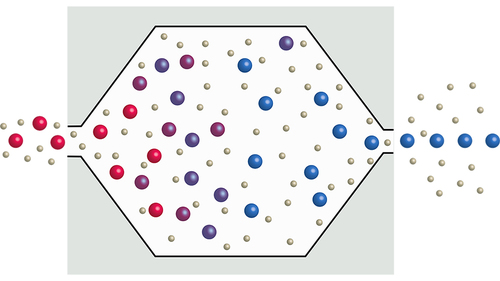Cold and controlled large molecules
We have demonstrated a cryogenic nanoparticle source capable of producing tightly focused beams of shock-frozen aerosolized nanoparticles and its quantitative description. Using a helium buffer-gas cell, isolated room-temperature particles are rapidly cooled, typically reaching liquid nitrogen temperatures within hundreds of microseconds, and quickly thermalizing with the buffer gas at 4 K. The current outlet of the cell acts as a simple fluid-dynamic lens, efficiently extracting particles and forming a focused beam. These beams were characterized through particle-localization microscopy. The cooling and focusing properties can be tuned by varying the helium flow rate and its temperature. A novel numerical simulation infrastructure was setup to provide quantitative simulations of particle trajectories and phase-space distributions, which are in very good agreement with the measurements. These simulations then enabled the extraction of cooling rates and particle temperatures, highlighting the very fast shock-freezing of nanoparticles.
The demonstrated high-flux beams of shock-frozen nanoparticles will be beneficial to a wide range of experiments in structural biology, nanoscience, and physics, including high-resolution single particle x-ray and electron diffractive-imaging. In particular, our approach, together with control and selection, will overcome the sample variability problem typically encountered in single-particle coherent x-ray diffraction measurements, where millions of particles are needed to create a 3D structure. Furthermore, the beams of cold isolated particles open up a large tool-box of control methods, originally developed for cold small gas-phase molecules, to these large nanoscale systems. These include the separation of structural isomers or major folding structures or molecular alignment approaches that fix molecules in the laboratory frame using optical fields. Such control would enable the experimental averaging of imaging data over many identical molecules/particles. Furthermore, it provides the prerequisites for future time-resolved studies of ultrafast biochemical dynamics, which require well-defined starting states to controllably and reliably trigger specific dynamic processes of interest. Additionally, the ability to control the particles' final temperature and cooling rate will allow the exploration of the ground-state potential energy landscape and answer important outstanding questions regarding the preservation of native-like conditions upon rapid-freezing. It furthermore enables the direct study of important temperature and size dependent phenomena in artificial nanoparticles, such as extremely large magnetoresistance or light-induced superconductivity. Furthermore, it could propel matter-wave interference to new limits.
Our approach enables imaging experiments that bring the benefits of CEM, well-controlled and static sample particles, to single-particle imaging where they can be imaged in vacuo without support structures and with ultrafast time-resolution. In turn, combining the very fast cooling enabled by our approach with soft-landing techniques could lead to strong and crucial progress in sample delivery in CEM experiments.
Research Team
Lena Worbs, Armando Estillore, Muhamed Amin, Amit Samanta, Jochen Küpper
